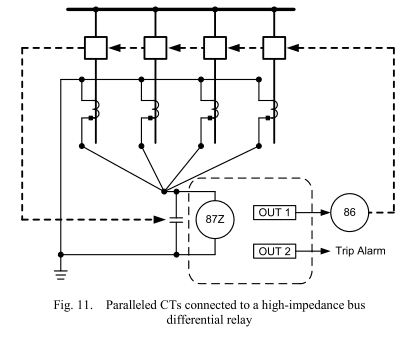- Published on
High-impedance vs low-impedance bus differential
- Authors

- Name
- Ben Gibb
In medium-voltage switchgear, there are few options for bus protection.
- Low-impedance bus differential
- High-impedance bus differential
- Zone-selective interlocking
- No bus differential protection and rely on overcurrent protection.
The key differentiator between low- and high-impedance bus differential is where the summation of currents occurs. In low-impedance bus differential, the summation is digital inside the relay. In high-impedance, the summation is physical through hard-wired connections. This is an important aspect as it drives the advantages and disadvantages of each protection method.
Let's start with some basics regarding the naming. Low and high-impedance bus differential schemes are named according to the relay current inputs. Low-impedance means the protection relay current inputs are low-impedance and similar to high-impedance protection relays.

How does high-impedance bus differential protection work
High-impedance bus differential has dedicated current transformers (CT) with their secondaries wired in to a summation common point. In normal operation, the CT secondary currents cancel. During a bus fault, there is a physical phasor difference in the CT secondaries. The differential current goes through a high-impedance circuit in the protection relay. Using Ohm's law, a voltage across the impedance is measured. The high-impedance protection relay is set to trip when the voltage reaches a pre-determined setpoint.
The high-impedance circuit is highly sensitive to small differential currents. As such, all CTs must have the same accuracy and ratios to prevent nuisance tripping.
For example, the SEL-787Z high-impedance relay uses a 2000 Ω resistor.
A metal-oxide varistor (MOV) is used in the high-impedance circuit to prevent high voltages. A normally open contact from the switchgear 86 lockout relay is used in parallel with the high-impedance. This contact provides a short-circuit for the differential current, thereby avoiding the MOV and impedance once the relay has tripped.
How does low-impedance bus differential protection work
Low-impedance bus differential has current transformers (CT) with their secondaries wired directly to the protection relay. Each CT has a separate channel on the relay. Algorithms in the relay apply a digital filter to obtain the fundamental frequency, and then add the phasor currents. Normal operation should equal zero, allowing for CT error as a minimum.
Advantages of high-impedance bus differential
- Saves on physical space. As the multiple currents are hardwired outside the protection relay, the amount of current inputs required on a high-impedance scheme is one per phase (as opposed to one per CT for low-impedance). This significantly reduces the size and number of protection relays required.
- Simpler to program and set up.
- Immune to CT saturation concerns.
Disadvantages of high-impedance bus differential protection
- Must have identical current transformers. The comparison of currents is done outside the protection relay (via hard-wired connections), therefore we can't rely on numerical correction inside the protection relay to adjust for different CT ratios or saturation.
- Must have dedicated current transformers - they can't be also used in series for metering or overcurrent protection. As the comparison of currents is done outside the relay, introducing other elements into the differential circuit would cause issues.
Advantages of low-impedance bus differential
- Low-impedance bus differential does not require dedicated current transformers. Due to the protection relay's low-impedance current inputs, the secondary current can be shared with other devices. Because there is an input for each CT, the protection relay can be programmed to adjust ratios to a common base.
- Low-impedance bus differential does not require identical current transformers. CTs can be different ratios and types, within reason.
Disadvantages of low-impedance bus differential protection
- Large protection relays and potentially require multiple relays.
- CT saturation for external faults is a concern to be addressed and mitigated.
